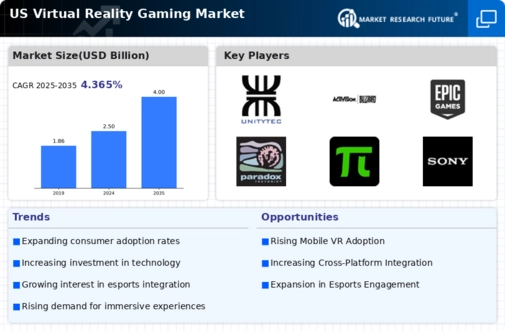Expansion of VR Content Libraries
The expansion of content libraries is a crucial driver for the virtual reality-gaming market. As developers create a wider array of games and experiences, the appeal of VR gaming increases. In 2025, the number of VR titles available in the US is expected to exceed 1,000, showcasing a diverse range of genres from action to educational games. This variety caters to different demographics, thereby broadening the market's reach. Furthermore, partnerships between VR companies and established gaming franchises are likely to enhance content quality and attract dedicated gamers. The growing availability of engaging content is essential for sustaining interest and investment in the virtual reality-gaming market.
Growing Popularity of Esports in VR
The intersection of esports and virtual reality is emerging as a significant driver for the virtual reality-gaming market. As competitive gaming continues to gain traction, VR is being integrated into esports events, offering unique experiences for both players and spectators. By 2025, the number of VR esports tournaments is expected to increase by 30%, drawing in larger audiences and sponsorships. This trend not only enhances the visibility of VR gaming but also encourages developers to create competitive titles tailored for esports. The growing popularity of VR esports could potentially lead to increased participation and investment in the virtual reality-gaming market.
Increased Investment in VR Startups
Investment in startups focused on virtual reality technology is significantly influencing the virtual reality-gaming market. Venture capitalists and tech giants are increasingly funding innovative companies that develop VR games and platforms. In 2025, investments in VR startups in the US are projected to surpass $2 billion, reflecting a strong belief in the market's potential. This influx of capital enables startups to experiment with new ideas and technologies, fostering creativity and competition. As these companies bring fresh concepts to the market, they contribute to a dynamic ecosystem that attracts gamers and investors alike, thereby propelling the virtual reality-gaming market forward.
Enhanced Social Interaction Features
The incorporation of enhanced social interaction features is transforming the virtual reality-gaming market. As players seek more immersive and engaging experiences, developers are focusing on creating social platforms within VR games. Features such as multiplayer modes, virtual meetups, and community events are becoming commonplace. In 2025, it is estimated that 40% of VR gamers in the US will engage in social gaming experiences, highlighting the importance of community in driving user engagement. This shift towards social interaction not only enriches the gaming experience but also fosters loyalty among players, thereby contributing to the sustained growth of the virtual reality-gaming market.
Technological Advancements in VR Hardware
The virtual reality-gaming market is experiencing a surge in technological advancements, particularly in hardware development. Innovations such as improved graphics processing units (GPUs) and lightweight headsets are enhancing user experiences. For instance, the introduction of 4K resolution displays and advanced motion tracking systems is making VR gaming more immersive. As of 2025, the market for VR hardware is projected to reach approximately $15 billion in the US, indicating a robust growth trajectory. These advancements not only attract new gamers but also retain existing users, thereby driving the overall market forward. The continuous evolution of hardware capabilities suggests that the virtual reality-gaming market will likely see increased engagement and higher sales figures in the coming years.























Leave a Comment